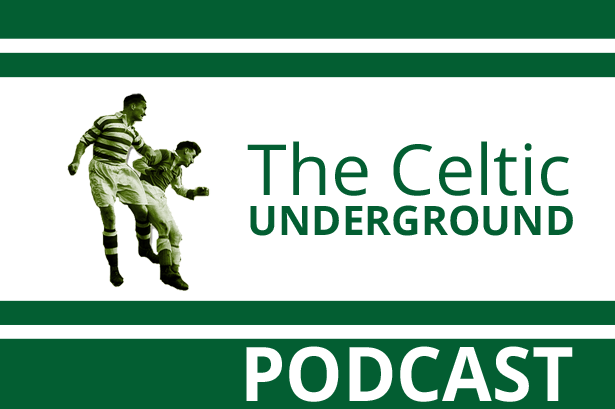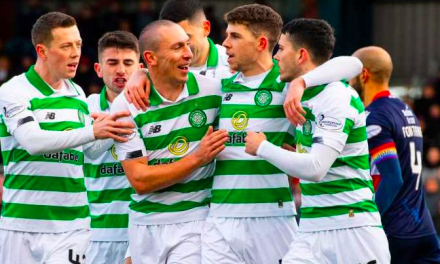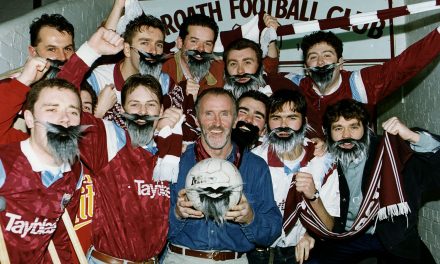In a few days’ time, Celtic will embark on a league campaign which every Celtic supporter hopes will end in them being the first Scottish club ever to win 10 league titles in a row. Only twice in the history of the Scottish game have two clubs had the opportunity to set out on a journey to reach the Holy Grail of 10 in a row and twice they have failed. There is a huge irony in that there were so many remarkable circumstances along the way when both Celtic and Rangers failed to do this previously. As someone who can clearly remember the despondency of failure in 1974-75 as opposed to the elation of success in 1997-98 allow me to explain why both attempts for the magic 10 collapsed.
The main reasons for both Celtic and Rangers failing was that:
- The heavy favourites lost on both occasions as complacency set in
- They both made the mistake of selling one of their most valuable assets in highly controversial circumstances
- Both teams grew old over the course of a long season and ran out of energy
- They both lost the crucial new year derby game
- They both collapsed in the run in
First up is Celtic….
1974 – CELTIC’S FIRST ATTEMPT AT THE 10
Who were favourites in 1974-75?
In the summer of 1974 Jock Stein was still viewed as being at the height of his powers. For the previous nine seasons Stein’s Celtic had won the Scottish league and the club had also made their mark in Europe by winning the European Cup in 1967, losing another final in 1970 and as recently as April 1974 had narrowly missed out on another European final by losing to Atletico Madrid in highly controversial circumstances. Celtic had won the league and cup double in May 1974 in convincing fashion and had blown the treble by losing the League Cup final against underdogs, Dundee. Three Celtic players – Hay, McGrain and Dalglish – had performed with distinction in the 1974 World Cup finals in West Germany and were reckoned to the be the backbone of the Celtic side for many years to come. Rangers, in comparison, had won no trophies the previous season and endured a barren spell where they could only boast four domestic trophies in the previous 10 years. In the 1973-74 season they had played Celtic on five occasions, losing four of them, and as the season approached this gave Celtic a huge psychological advantage.
Which player did Celtic sell which was to set them back?
David Hay had blossomed into a world class player due to his performances in that summer’s World Cup tournament. In the memorable 2-0 win over England at Hampden in May 1974 he had been the driving force in a fine Scotland team and had carried that form into the finals in West Germany. Hay had experienced problems with Celtic management over contractual issues then seemed to have resolved them and had decided to sign a new contract with Celtic upon his return from West Germany. He was shocked to find that Jock Stein was willing to sell him and, with his stock now high, Chelsea had bid the highest with a Scottish record fee of £250,000. Celtic supporters were stunned at the news, particularly as Hay was viewed as a future Celtic captain. Hay may not have been a match winner in the shape of a Johnstone or a Dalglish but Celtic were to rue his departure during the long winter months on heavy pitches.
The team grew old together?
As the campaign progressed it was obvious that some Celtic players were now on the wane. In previous years the backbone of the team had been provided by the experienced grouping of McNeill, Brogan, Johnstone, Lennox, Callaghan, Deans and Hood. All of them were either approaching 30 or were over that notable age, in an era where players turning 30 were perceived as being past their best. Rangers’ team was younger and, for once, showed more desire. The defence, in particular, was a problem and began to lose soft goals and lacked pace, something that could not have been levelled at them in the previous nine seasons. Rangers had players who made excellent contributions to their cause such as Jardine, Forsyth, Johnstone, McLean and Parlane. Men who would be the focal point of their team for years to come.
New Year derby disaster
Celtic were top of the table and strong favourites going into the Ibrox fixture on 4 January 1975. They were very unlucky to go in 1-0 down at half time as they had created the better chances and played the better football. However, in a muddy second half Rangers took control to run out deserved 3-0 winners. This was a catastrophic blow for Stein’s Celts and was the first real indication of having missed Davie Hay’s strength and determination in the middle of the park. However, no one could have foresaw the collapse that came during the early months of 1975. This setback affected Celtic greatly and a side which until recently had looked domestically invincible began to struggle.
Pressure on the team during the run in
After the Ibrox defeat Celtic went into a spiral. For a team which won the other two domestic trophies available to them that season it was perplexing how Celtic’s league form was so poor post-New Year. Draws at home to Arbroath and Dumbarton and defeats to Dundee United and Airdrie were particularly poor results. After February it was obvious that it was to be Rangers’ title and that Celtic’s reign was over. It was only a matter of time and Rangers clinched the title at Easter Road on 29 March 1975.
And now to Rangers….
1997 – RANGERS ATTEMPT AT THE 10
Who were favourites in 1997-98?
At the beginning of the season Rangers were viewed as massive favourites to reach 10 in a row. That summer had seen the Ibrox side spend money on a scale unknown to any other Scottish club up to that time. An array of expensive European players were procured from across the continent at a cost in excess of over £15m. The media boasted that Rangers could actually boast three different teams, one for Europe, one for the league, and one for the League Cup. The sides were along the lines of:
Team 1: Goram – Clelland Gough Bjorklund Porrini – Laudrup Gascoigne McCall Albertz – McCoist Negri
Team 2: Niemi – Stensaas Petric Amoruso Vidmar – I Ferguson Gattuso Thern Van Vossen – Durie Johansson
Team 3: Snelders – Wright McLaren Moore Bollan – B Ferguson McInnes Miller Durrant – Rozenthal Anderson
Rangers had won their nine in a row series of league titles with a host of domestic cups. In comparison, Celtic had won only two Scottish Cups and a League Cup during that period. They had sacked their popular manager, Tommy Burns, and replaced him with a hugely unknown quantity in Wim Jansen. Celtic had also sold their main assets in Pierre Van Hooydonk, Paulo Di Canio and Jorge Cadete, for big fees and were perceived as being severely weakened and unlikely to be able to mount a challenge.
Which player did Rangers sell to set them back?
Paul Gascoigne had joined Rangers in a blaze of publicity in 1995 and has been an inspiration for them in the title wins in 1996 and 1997. He was a proven match winner and gave Rangers a different dimension from middle to front. In March 1998, with Celtic and Rangers slugging it out for the title, Rangers inexplicably sold Gascoigne to Middlesbrough. Give that after this Rangers lost vital games to Motherwell, Aberdeen and Kilmarnock, their fans were not happy and still view this as an act of betrayal from the club until this day. In those last few vital league games, Gascoigne could have been the inspiration to take Rangers to 10 in a row. It would appear that Rangers grew tired of Gascoigne’s ‘extracurricular activities’ but even now it seems a case of cutting their nose off to spite their face.
The team grew old together?
Very similar to Celtic’s squad in 1975, this Rangers squad had a vast amount of experience but as the season progressed it seemed their hunger and desire was gone. Gough, Goram, McCoist, McCall, Durie, Ferguson and Durrant had all been great servants but were now perceived as being past their best and opposition teams sensed this and viewed Rangers as being vulnerable. Gough had actually moved to the USA in the summer of 1997 but was brought back quickly when the defence looked unstable without his presence. This was seen as a panic move to cover up cracks which were fast beginning to emerge. Celtic’s team was viewed as being younger and more energetic with the likes of McNamara, Donnelly, Burley, Lambert and Larsson.
New Year derby disaster
Rangers were viewed as slight favourites when they travelled to Celtic Park for the New Year derby game on 2 January 1998. Just days previously Celtic had lost at McDiarmid Park to St Johnstone and this was viewed as a must win game for the Celts. Celtic had not won a meaningful league game against Rangers since August 1994 and the pressure very much was on them. Inspired by their new signing from Borussia Dortmund, Paul Lambert, Celtic dominated the game from start to finish and now seemed to have renewed mental strength. It took two late goals from Burley and Lambert to give them the win which was richly deserved, with Rico Annoni fondly remembered for performing a great man-marking job on Rangers’ talisman, Brian Laudrup. This game gave Celtic and their fans enormous confidence that they could now go on and win the title. Without this win it is highly unlikely that Celtic could have prevailed at the end of that season.
Pressure on the team during the run in
For the first time in many years Rangers began to look vulnerable in the league as the season moved on. After the Celtic New Year defeat they lost to St Johnstone, Motherwell, Aberdeen and Kilmarnock, which is not title winning form, something which had not happened in previous campaigns under Walter Smith. Add a few draws in there and that was enough to give Celtic a very slight advantage and they took their chance. Rangers’ dream of 10 in a row, which had looked a certainty in August 1997 was now dead in May 1998 although it should be noted that they took Celtic to the very last game in a tight finish.
CONCLUSION
As the evidence above suggests, the odds are stacked against Celtic to achieve 10 in a row, no matter how many people see them as favourites before the new season starts. It’s interesting to note that on the previous two occasions from vastly different eras, it was the underdogs who won with the burden of being strong favourites weighing down the favourites. This is something the current Celtic side and their supporters, should do well to remember.
Gerry McNee once said that Celtic and Rangers fighting over 10 in a row was comparable to ‘two bald men fighting over a comb.’ There is an element of truth in this and this was further highlighted in Roger Mitchell’s recent interview with Paul Dykes in which he said that Celtic should be looking beyond parochial success and having greater ambitions on the European front. This is undeniably true also, but only serves to hide the fact that Celtic reaching the Holy Grail of 10 in a row will give their fans bragging right for decades to come. It may not exactly be a once in a lifetime chance but it gives the current Celts a chance to do something no one has done before. In view of this, everything that Celtic have should be thrown at achieving the magic ‘10’. Anything less will be seen as an act of betrayal by their supporters. Celtic have no divine right to win 10 in a row. But they do have a marvellous opportunity to create history which they may never have ever again.





